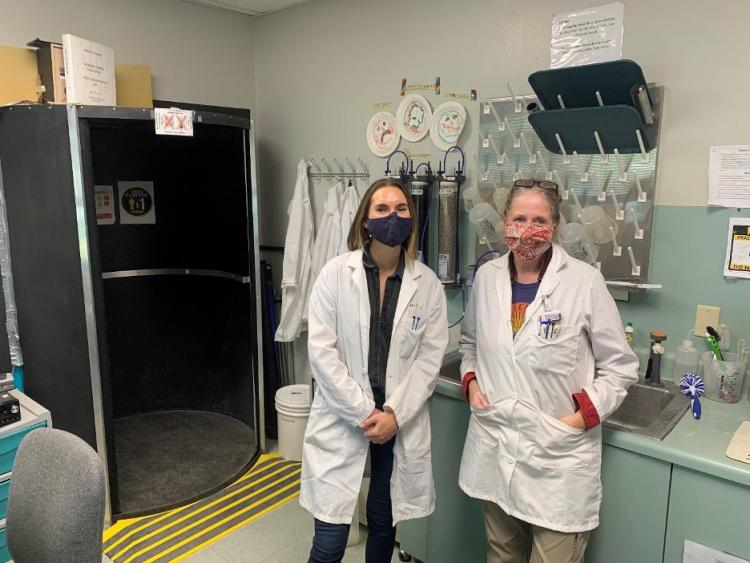Julianne Scamardo - Project Profile
2021 AGeS awardee
Lab: USU Luminescence Laboratory
Lab Mentors: Tammy Rittenour
What scientific question(s) does your research address and what motivates this work?
Floodplains along non-perennial streams – including intermittent rivers and ephemeral streams – provide important ecosystem functions in dryland habitats. Wide floodplains on non-perennial streams can be important areas of sediment storage, vital habitat corridors, and hotspots for biodiversity. These functions are thought to be closely tied to geomorphic heterogeneity, or the number and diversity of landform patches within the floodplain. As a part of this project, myself and others were interested in understanding drivers to geomorphic heterogeneity in non-perennial floodplains over time. Specifically, how does sediment cycling and floodplain reworking by flash floods influence geomorphic heterogeneity? To answer this question, we studied a range of floodplains adjacent to non-perennial streams in southern Utah, USA. Given the lack of historical high-resolution imagery and observations as well as a lack of modern flow data in many non-perennial streams, geochronology offers a unique look into how time influences floodplain heterogeneity.
What chronometric tool did you employ and why?
I used single-grain optically stimulated luminescence (OSL) of quartz sand sampled 1-m or more below the modern-day floodplain surface in seven separate floodplain reaches across southern Utah. Samples were analyzed in the Utah State University Luminescence Lab run by Dr. Tammy Rittenour. Luminescence dating was ideal for our study sites due to the abundance of quartz-rich, sandy exposed banks, a regional record of prior studies using OSL to date fluvial sediments, and limited material suitable for other dating techniques, such as organic material for radiocarbon dating. However, OSL dating of dryland fluvial sediments can be challenging, due to short transport times during sediment-laden flash floods, which can potentially lead to only partial bleaching or resetting of the luminescence signal resulting in overestimated burial ages. To limit the potential for age overestimation, we used single-grain OSL and a minimum age model, which recognizes younger grains as likely representing the true age of the deposit.

Figure 1: Sampling sediment for OSL dating in Indian Creek (Southern Utah, USA) with the help of field assistant, Shea Slonkosky.
What were some of the key takeaways of your research?
- Ages correspond to regional arroyo filling cycles: Sampled sediment was deposited approximately 500 to 800 years before present, which suggests that modern-day floodplains developed after a regional period of known arroyo cutting and filling that occurred between 1200 to 1400 CE.
- Non-linear relationship between storage time and surface heterogeneity: Intermediate storage times (and likely, intermediate floodplain disturbance intervals) correlated to the highest geomorphic heterogeneity.
- Need for more temporal rather than spatial studies: Results highlighted the impact of timescale on geomorphic unit diversity, which indicates a need for more studies tracking geomorphic unit evolution through time rather than simply through space.
What new experiences, opportunities, and collaborations did you gain as an AGeS-Grad awardee?
As a field-based scientist, I rarely get the opportunity to don a lab coat and examine my sediment samples intensively in a lab-based setting. The AGeS grant and OSL dating gave me an opportunity to see my field sites and the processes occurring there through a new lens. Also, through the experience of collecting, processing, and interpreting my OSL samples, I feel that I have gained a deeper understanding of the technique and how to apply it to my future research than if I were to simply send my samples away for analysis. Beyond new perspectives and techniques, being an AGeS-Grad recipient has connected me with multiple new colleagues and collaborators. From Dr. Tammy Rittenour and others in the Utah State University Luminescence Lab to fellow AGeS awardees, I feel that I have been given the opportunity to learn and connect with multiple knowledgeable and supportive geoscientists!
What is one piece of advice you have for future AGeS-Grad award applicants or awardees?
Reach out early to the lab that you are interested in working with for your award. Having input on sampling techniques and locations can be vital to the success of your project!

Figure 2: Visiting the Utah State University Luminescence Laboratory in October 2021.

